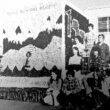Photos don’t lie. Or do they?
Though our main focus here at The New Era is on issues and activities in Sweet Home, we are interested in things our fellow news reporters and editors are dealing with that resonate in our newsroom as well. A number of journalism review magazines and Web sites deal with such issues, issues that I and staff writer Sean Morgan have occasionally discussed on this page in the past.
Recently, we received an article that dealt with such an issue: digital manipulation of photographs.
Digital photography has revolutionized both print and broadcast journalism. The ability to take a photo and have it on the newspaper page, ready to go to press, in literally five minutes is a far cry from the old days of film, darkroom chemicals, enlargers and exponentially greater time required to replicate what I just described. Former Publisher Alex Paul has mentioned many times how many hours he spent developing and printing photos for this newspaper. I’ve told him every time: “I envy you not at all.” I’ve done my time in the darkroom and digital is so much better for what we do here that I can’t really even come up with proper adjectives to describe it.
But there is a down side (in addition to the ease of losing digital files on one’s computer). That is the temptation to improve photos to the point that it becomes unethical. That was the topic of the article Sean and I read.
There have been a number of well-publicized cases of this involving respected and highly experienced photojournalists, often in war zones, who have added or subtracted elements from their photos to make them better.
The most recent case, which prompted this particular article, was an Ohio photographer, Allan Detrich of the Toledo Blade, who was discovered after he removed legs from a photo of baseball players kneeling in prayer in the outfield of the Bluffton University baseball team, which had lost five of its athletes in a tragic bus accident a few weeks earlier. Many photographers were there to record the occasion and all their photos, taken from pretty much the same spot, showed a pair of legs sticking out below a sign on the outfield fence. All, that is, except this particular photographer’s. He’d removed the legs with Photoshop, a software program commonly used by photographers to prepare their digital photo images for publication.
When the Blade’s editors were alerted, they immediately reviewed Detrich’s previous work and found other instances where he’d erased unwanted elements from his photos (people, tree limbs, utility poles, wires, light switches and cabinet knobs) or added them (tree branches or shrubbery, a hockey puck, a basketball).
The latter was a classic example of a photographer giving in to temptation. The original photo showed a group of female basketball players reaching into the air, grasping for … nothing that showed up in that photo. Detrich inserted a basketball at the point where the players’ eyes were focused. It was a great photo. But it wasn’t true.
And that’s the issue here. If you knew that a photographer might be inserting elements into a photo, or taking elements out, that journalism wouldn’t be credible at all. And if journalism has no credibility, there’s no point in listening to or reading news reports.
Here at The New Era, we follow those rules. We try to be as fair and balanced as possible, given time constraints (deadlines) and our ability to reach sources who can add pertinent information to a story. We do the same with photos.
We have, on rare occasions, “fixed” hand-in photos from outside sources that contain extraneous material such as date the photo was shot (usually in garish, fluorescent red letters) or the names of sports team members or other stuff that weren’t part of what the camera was “seeing” when the original photo was shot.
On even rarer occasions, we have touched up an obituary photo or mug shot, which were also hand-in photos, that contained half of someone else’s head or some other distracting, extraneous content. If the rest of the photo had a plain background, we have on rare occasions digitally cut out the person we were supposed to picture and patched in the rest with the plain background. That’s it.
We believe that doing so maintains the integrity of the photo’s intent, which was provided to us to show the person(s) whom we are showing. When you’re looking at a photo provided by the family of someone who’s passed away, having half of someone else’s head in the photo doesn’t do much for the visual impact of the departed. But that’s as far as we will ever go. We never add or subtract elements from our own news photos because what the camera sees is what you need to see.
We understand the temptation to which these photojournalists have fallen victim. It’s too easy to fix a bad photo these days and photographers are often very artistic. They strive for perfection on every shot.
But it violates basic standards of print journalism today and those who violate them are usually summarily fired.
Those rules are the ones we follow here at The New Era because we want our photos to tell the truth.




